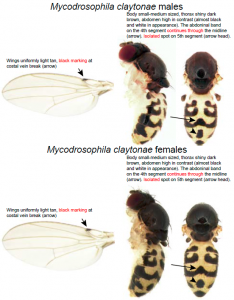The upcoming HMWF newsletter features two researchers who have been documenting, over the last several years, the huge biodiversity of moths at Huron Mt. I’ve written about this work before, but wanted to recognize a recent achievement by one of these researchers in another arena. Dr. Thomas Werner (Michigan Technological University) has also been documenting diversity in fruit flies (members of the family Drosophilidae) — those tiny creatures that seem to turn up whenever your fruit or vegetables get a little too ripe.

An illustration from the Werner and Jaenike “Guide”. This fungus-loving species, with striking black and white markings, is found at Huron Mt.
Fruit flies are not a group that gets a lot of attention in biodiversity circles. We’re more likely to think of them as lab ‘model organisms’ for genetics study (if you took a college bio or genetics class, you may have spent time counting mutant Drosophila melanogaster). But most of us, in fact, probably assumed they’re all the same. In fact, there are several dozen species in the northeastern North America, and Werner has so far discovered twenty-two at Huron Mountain (including D. melanogaster), using traps with bananas, tomatoes, and mushrooms as bait.
However, my main agenda for this post is to congratulate Thomas and his co-author (Dr. John Jaenike, University of Rochester) on the publication of what will likely become the authoritative work on fruit flies of our larger region, Drosophilids of the Midwest and Northeast. The book is published online and is freely available at http://humanities.lib.rochester.edu/drosophilaguide/ (courtesy of the University of Rochester libraries and ‘creative commons’ licensing). There is also a free poster you can download and print.
The book includes beautifully executed photographs of every species, developed using ‘photo-stacking’ techniques for exquisite clarity and focus throughout the photo. While it’s true that a number of the species list are pretty nondescript-looking, there is also considerable variation in size, color, and marking, and some species are quite striking (see the photo in this post). It’s also interesting to note that several of the species listed are non-native pests, and some of these do occur at Huron Mt.
The book also includes rearing instructions and recipes for media for raising fruit-fly larvae if you’re interested.
(The title of this post, by the way, references an old joke that I like because it illustrates the complexities and delightful ambiguities of the English language: “Time flies like an arrow; fruit flies like a banana.”
